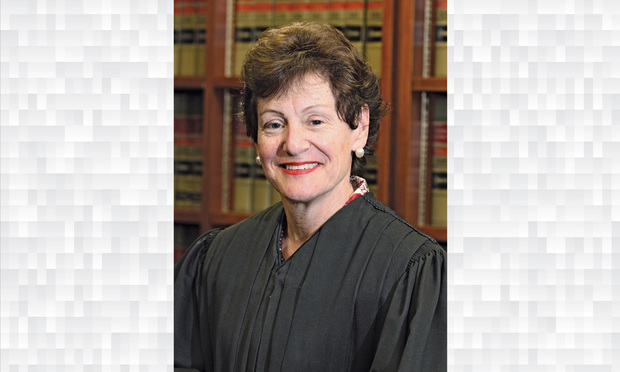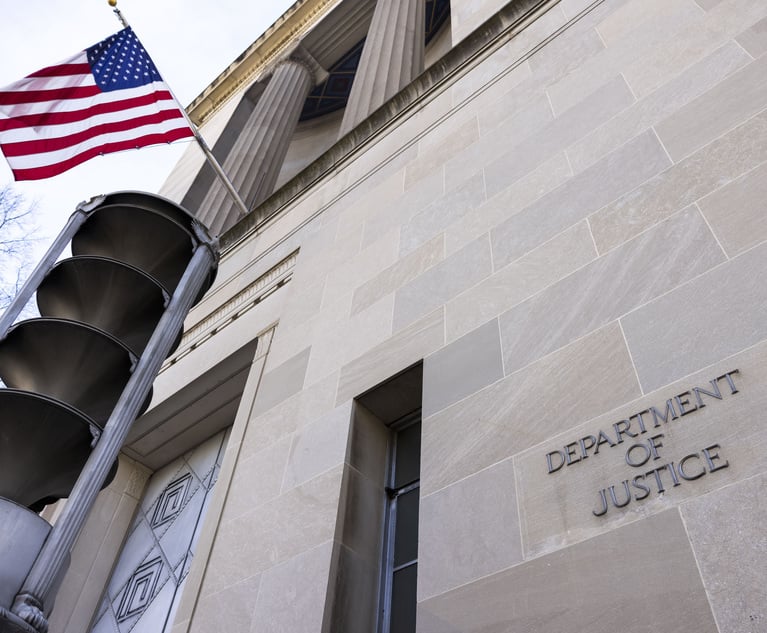Texas Chief Judge Barbara Lynn Reflects On Pros, Cons of First Jury Trial Amid COVID-19
"I think courts are going to have to consider the extraordinary exhaustion of resources to have a trial under these conditions. I used three courtrooms. We spent significant money purchasing supplies," said Chief Judge Barbara Lynn of the U.S. District Court for the Northern District of Texas in Dallas.
June 09, 2020 at 02:13 PM
6 minute read
 Chief Judge Barbara Lynn of the U.S. District Court for the Northern District of Texas in Dallas. Courtesy photo.
Chief Judge Barbara Lynn of the U.S. District Court for the Northern District of Texas in Dallas. Courtesy photo.
After the first in-person jury trial in the post-coronavirus era, the jury expressed gratitude and gave a round of applause for the infection-control precautions that the judge put into place for the trial.
Chief Judge Barbara Lynn of the U.S. District Court for the Northern District of Texas in Dallas became the first judge in Texas, and perhaps the nation, to hold a jury trial since March, when courthouse doors around the country closed to in-person proceedings. The criminal trial took place June 1-3.
We spoke to Lynn about what went well, things she'll change next time and what other courts might take away from her jury trial experiment.
Here are her answers, edited for brevity and clarity.
Read more: Jury Trials Are Back in Texas. Here's What You Should Know
Why did you decide to hold last week's jury trial?
It was obvious that the courts would be starting up again with jury trials within either June, July, or August. My conclusion was that we should have at least one trial that we could use to see whether we could safely conduct a trial, and if so, how.
I decided that I would try to have a trial, recognizing the need for the justice system to continue but also the need to conduct a trial safely for the participants, including the jury and the lawyers and court personnel.
Can you tell me what went well?
I think the best thing about it is we were able to have it at all. There was a remarkable response of the panel. We had more than enough people come to court and be willing to serve.
I have to say that in general, once the trial started, I thought it was pretty much like a regular trial. Obviously, the participants were wearing masks or face shields. We had the witnesses take off their face coverings once they got in what we created: a place in the jury box that we walled up with Plexiglas on two sides. Other than that, everybody in the courtroom was wearing a mask or face covering. That was different.
Because of where the jury was sitting, the lawyers had their backs to me. I put a camera on the back door on a tripod so I could monitor on the bench the viewpoint from the jury.
We didn't have any bench conferences, so during the trial, I had to communicate with the lawyers at least once on an objection—where they would have approached the bench—by email.
What would you change next time?
A public health specialist agreed to come in and look at what we are doing and see if they have any additional suggestions for safety, or whether some things we were doing for safety are considerably adding safety. The Plexiglas screens—there are some breaks in them, some small places where they don't connect tightly, because they are on wheels. I'm trying to figure out a way to close those gaps.
Some lawyers have told me they would rather not be wearing a mask when they are talking to the jury. That may be okay. I did put Plexiglas in a v-shape around the lecture where they were standing and talking to the jury.
You were using clear plastic face shields, which still allow people to see each other's faces?
Before I did the trial, I had a round table with defense lawyers and a separate one with prosecutors. One of the comments was lawyers wouldn't want to pick a jury without seeing the faces of the jury. That was a solution to that.
The jury elected to wear those. Most of them wore the face shields.
What would you say to criminal-defense lawyers who may have concerns about a fair trial in these circumstances?
I am very mindful of the need to provide due process to criminal defendants. There are very few things as important as that. I was trying to see if we could do that while providing health and safety for the participants. I hope we succeeded in that. There's always room for improvement, and I'm going to be mindful of anything and everything I can do to improve. I asked the lawyers in the trial to give me feedback, about what they thought could be done better, to facilitate a better presentation or additional safety measures.
I don't see a time in the future we're going to bring 40 people into the courtroom at the same time. We have to work together constructing a system that serves the interests of justice, and due process concerns of criminal defendants.
What do you think that other courts take away from your experiment?
I think courts are going to have to consider the extraordinary exhaustion of resources to have a trial under these conditions. I used three courtrooms. We spent significant money purchasing supplies, and it will become more and more challenging when we have a trial, with multiple defendants, multiple counts, and greater length.
I think you will see some stick their toes in the water, but it's not going to be back to business as it used to be.
At the conclusion of the trial, the foreman raised his hand, and I called on him. He stood up and wanted me to know that the jurors wanted to tell me how grateful they were for all the safety measures put in place. They wanted me to know they felt comfortable doing their work. Then they gave me a round of applause. It was a great relief that they felt that way.
This content has been archived. It is available through our partners, LexisNexis® and Bloomberg Law.
To view this content, please continue to their sites.
Not a Lexis Subscriber?
Subscribe Now
Not a Bloomberg Law Subscriber?
Subscribe Now
NOT FOR REPRINT
© 2025 ALM Global, LLC, All Rights Reserved. Request academic re-use from www.copyright.com. All other uses, submit a request to [email protected]. For more information visit Asset & Logo Licensing.
You Might Like
View All
Government Attorneys Face Reassignment, Rescinded Job Offers in First Days of Trump Administration
4 minute read
Gibbons Reps Asylum Seekers in $6M Suit Over 2018 ‘Inhumane’ Immigration Policy
3 minute read
Law Firm Sued for Telemarketing Calls to Customers on Do Not Call Registry

Internal Whistleblowing Surged Globally in 2024, So Why Were US Numbers Flat?
6 minute readTrending Stories
- 1We the People?
- 2New York-Based Skadden Team Joins White & Case Group in Mexico City for Citigroup Demerger
- 3No Two Wildfires Alike: Lawyers Take Different Legal Strategies in California
- 4Poop-Themed Dog Toy OK as Parody, but Still Tarnished Jack Daniel’s Brand, Court Says
- 5Meet the New President of NY's Association of Trial Court Jurists
Who Got The Work
J. Brugh Lower of Gibbons has entered an appearance for industrial equipment supplier Devco Corporation in a pending trademark infringement lawsuit. The suit, accusing the defendant of selling knock-off Graco products, was filed Dec. 18 in New Jersey District Court by Rivkin Radler on behalf of Graco Inc. and Graco Minnesota. The case, assigned to U.S. District Judge Zahid N. Quraishi, is 3:24-cv-11294, Graco Inc. et al v. Devco Corporation.
Who Got The Work
Rebecca Maller-Stein and Kent A. Yalowitz of Arnold & Porter Kaye Scholer have entered their appearances for Hanaco Venture Capital and its executives, Lior Prosor and David Frankel, in a pending securities lawsuit. The action, filed on Dec. 24 in New York Southern District Court by Zell, Aron & Co. on behalf of Goldeneye Advisors, accuses the defendants of negligently and fraudulently managing the plaintiff's $1 million investment. The case, assigned to U.S. District Judge Vernon S. Broderick, is 1:24-cv-09918, Goldeneye Advisors, LLC v. Hanaco Venture Capital, Ltd. et al.
Who Got The Work
Attorneys from A&O Shearman has stepped in as defense counsel for Toronto-Dominion Bank and other defendants in a pending securities class action. The suit, filed Dec. 11 in New York Southern District Court by Bleichmar Fonti & Auld, accuses the defendants of concealing the bank's 'pervasive' deficiencies in regards to its compliance with the Bank Secrecy Act and the quality of its anti-money laundering controls. The case, assigned to U.S. District Judge Arun Subramanian, is 1:24-cv-09445, Gonzalez v. The Toronto-Dominion Bank et al.
Who Got The Work
Crown Castle International, a Pennsylvania company providing shared communications infrastructure, has turned to Luke D. Wolf of Gordon Rees Scully Mansukhani to fend off a pending breach-of-contract lawsuit. The court action, filed Nov. 25 in Michigan Eastern District Court by Hooper Hathaway PC on behalf of The Town Residences LLC, accuses Crown Castle of failing to transfer approximately $30,000 in utility payments from T-Mobile in breach of a roof-top lease and assignment agreement. The case, assigned to U.S. District Judge Susan K. Declercq, is 2:24-cv-13131, The Town Residences LLC v. T-Mobile US, Inc. et al.
Who Got The Work
Wilfred P. Coronato and Daniel M. Schwartz of McCarter & English have stepped in as defense counsel to Electrolux Home Products Inc. in a pending product liability lawsuit. The court action, filed Nov. 26 in New York Eastern District Court by Poulos Lopiccolo PC and Nagel Rice LLP on behalf of David Stern, alleges that the defendant's refrigerators’ drawers and shelving repeatedly break and fall apart within months after purchase. The case, assigned to U.S. District Judge Joan M. Azrack, is 2:24-cv-08204, Stern v. Electrolux Home Products, Inc.
Featured Firms
Law Offices of Gary Martin Hays & Associates, P.C.
(470) 294-1674
Law Offices of Mark E. Salomone
(857) 444-6468
Smith & Hassler
(713) 739-1250








